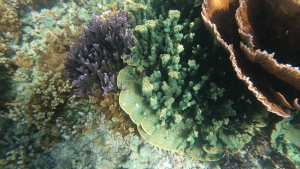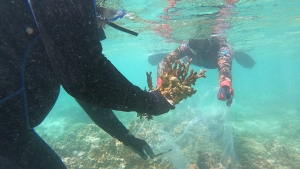Recently extracted non-native coral species from patch reefs in Oʻahu’s Kāneʻohe Bay were donated to the Waikīkī Aquarium for bio-secure housing and display. The donation came from a team from the Department of Land and Natural Resources Division of Aquatic Resources (DAR), with support from numerous partner organizations including the University of Hawaiʻi at Mānoa’s Hawaiʻi Institute of Marine Biology (HIMB).

“The Waikīkī Aquarium is grateful for this opportunity to work closely with DLNR/DAR and its partners to remove these non-native corals. They were clearly planted there deliberately several years ago, but do not belong on Hawaiʻi‘s reefs,” said Andrew Rossiter, Waikīkī Aquarium director. “The Waikīkī Aquarium will provide them the only home suitable for these and other non-native corals in Hawaiʻi—behind the glass of a public aquarium.”
The DAR Aquatic Invasive Species (AIS) Program received the first report of a non-native coral on May 13, 2020, from Hiʻilei Kawelo, executive director of Paepae o Heʻeia. Her father, Gabby Kawelo, first observed the unusual corals in 2018.
“They didn’t look like anything, anyone in my family has ever seen before, and we’ve been diving regularly in the bay for generations,” said Hiʻilei. “My sister Kapua and I reached out to members of the scientific community and to natural resource managers. Pictures were circulated to experts familiar with Hawaiian corals, and none of them identified the species observed as native species.”
“Our team is responsible for rapidly responding to new reports of non-native aquatic species and assessing next steps for management. Non-native species have the potential to become invasive and negatively impact our native ecosystems, the economy and human well-being,”explained AIS team lead and aquatic biologist Kim Fuller. “It is necessary to respond to non-native species reports in a timely manner before they have time to establish and spread.”

Fuller noted that 12 colonies appeared to be non-native and were comprised of three species. The colonies ranged from 7 inches to 4 feet in diameter and included a purple branching coral that was unlike any native branching corals observed in the main Hawaiian Islands. The footprint of the area with the non-native coral colonies was between 7 feet and 9.5 feet.
Experts from National Oceanic and Atmospheric Administration (NOAA), U.S. Fish and Wildlife Service, HIMB and the Heʻeia National Estuarine Research Reserve were consulted about species identification and removal of the corals.
Samples were collected from each suspected species and submitted to Robert Toonen, a coral expert at HIMB, for genetic analysis. “These corals look a lot like some that I know are popular in the aquarium trade and thorough analysis revealed that they definitely are not native,” Toonen said.
Samples also were sent to a NOAA lab for further identification. NOAA’s Doug Fenner identified the orange foliose coral as Montipora foliosa, the purple branch coral as Montipora digitata and the green polyp coral as either Montipora stellata or Monitipora carinita. Bishop Museum also received samples for its collection.

